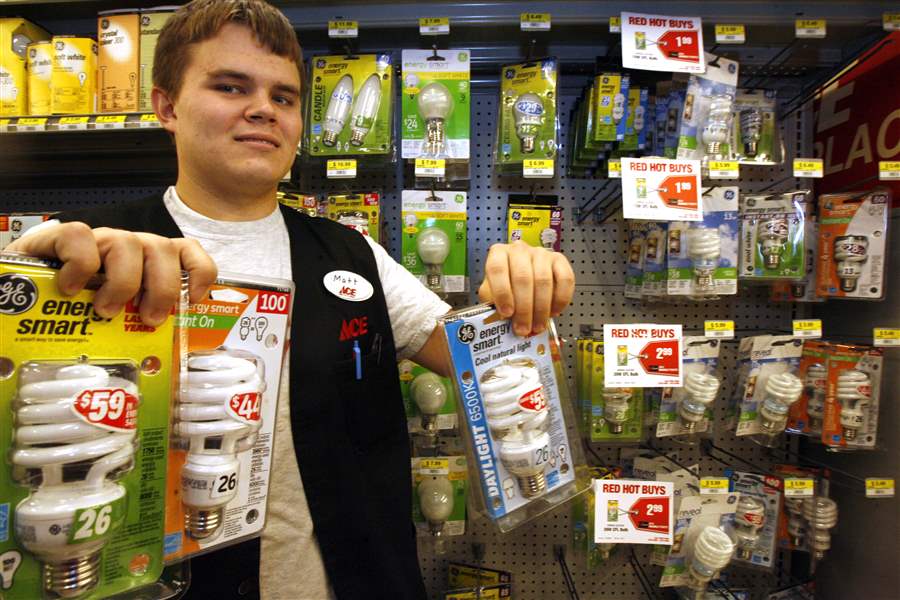
FirstEnergy delays efficient-light idea
10/9/2009
Matt Murnen, a marketing student at the University of Toledo who works at Werkman's Ace Hardware, holds energy-efficient bulbs like the ones FirstEnergy wants to distribute for $10.80 each.
Jetta Fraser
A plan by FirstEnergy Corp. to distribute energy-efficient light bulbs and place the cost on customers' bills has been put on hold - for now.
The utility said late yesterday that the program, designed to cut energy usage, has been postponed to let company and state regulators talk more.
Alan Schriber, chairman of the Public Utilities Commission of Ohio, said, "It should be held off until we can actually tell people how much it costs, and why it costs that much."
FirstEnergy of Akron, which owns Toledo Edison and two other Ohio utilities, announced this week that it planned to hand deliver or mail, starting Monday, about 3.75 million compact fluorescent bulbs to residential customers. Each customer would get two 100-watt bulbs. Toledo Edison has about 300,000 customers.
The company, which bought the bulbs, said it would charge 60 cents per month on customer bills over three years, or about $21.60. The bulbs would be hand-ed out and the customers would be billed whether they wanted the bulbs or not.

Matt Murnen, a marketing student at the University of Toledo who works at Werkman's Ace Hardware, holds energy-efficient bulbs like the ones FirstEnergy wants to distribute for $10.80 each.
Comparable fluorescent bulbs can be purchased at area retailers for $6 or less. One Toledo area home improvement store yesterday sold a package of four such bulbs for $8.
The program drew criticism about the costs and methods from consumers, legislators, and even Gov. Ted Strickland.
Mr. Schriber said he was "totally blindsided" by both the company's plan to distribute the bulbs and its plan to charge $21.60 for them. A plan for the program was approved, but contained only estimates, he said.
"We didn't know they were launching it. Before you throw numbers out there, they don't go on any bill unless they are approved here," he said. "And they were not approved here."
FirstEnergy spokesman Ellen Raines said the firm's position is that it had approval to give out the bulbs and to charge customers. Its plan was submitted July 9 to state regulators and approved Sept. 23, she said.
Given the controversy, the company agreed to hold off on handing out the bulbs, but it didn't say for how long.
Under Ohio's new energy law, the Akron company is required to get its customers to reduce energy use by 22.2 percent by 2025. The new bulbs were expected to contribute to that reduction - with estimates that it could cut power usage by 167 million kilowatt hours, as the bulbs use less energy and last longer than traditional incandescent lighting in most homes and some businesses.
Meetings over the program were held with company officials, state regulators, the Ohio Consumers' Counsel, legislators, and others.
Said Ms. Raines: "We filed a plan that reflected input from the group. There was agreement that this was the best way to cut power usage and the plan was very specific."
Under FirstEnergy's state-approved plan that sets its rates, if the utility undertakes programs to cut energy usage as required, it is allowed to recoup that cost.
The $21.60 charge, Ms. Raines said, would cover the cost of the bulbs, their delivery expense, and offset a loss in revenues to the firm for the expected lower electricity usage resulting from the energy-efficient lighting.
"This is a very unusual situation to be in, in that we have been required by law to reduce the amount of product we sell," she said.
The energy-efficient bulbs, the company has said, would save a homeowner up to $60 over the life of the bulb.
Mr. Schriber said FirstEnergy should be compensated for the bulbs and their distribution. But recovering revenues for decreases in energy usage is another matter.
If the predicted reduced electricity usage keeps the company from having to build a new power plant, then the utility should share those savings with customers, he said.
People were angered, Mr. Schriber said from feedback he received this week, at having no choice to accept the bulbs, and they balked at the $10.80-per-bulb fee.
The PUCO's staff estimated the retail costs of such bulbs at $5, while the Consumers' Counsel staff put the cost around $3.
Anthony Rodriguez, a spokesman for Ohio Consumers' Counsel, said it had advocated that FirstEnergy use a voucher plan or a coupon plan used by other utilities, rather than the more aggressive distribute-and-charge plan.
"I think there was some writing on the wall with this. We told FirstEnergy we didn't really like the design of their program and that we had seen it done in other states and there was a big backlash," Mr. Rodriguez said.
However, he said, the bulbs FirstEnergy has purchased for the program are top-rated and paying for the bulbs "is a cheaper alternative than building a new power plant."
FirstEnergy did back a voucher plan instead, Ms. Raines said, but the members at the meetings collectively agreed that too few people would redeem the vouchers to make much of a difference in electricity usage. So, the bulb plan was preferred, she said.
Contact Jon Chavez at:
jchavez@theblade.com
or 419-724-6128.